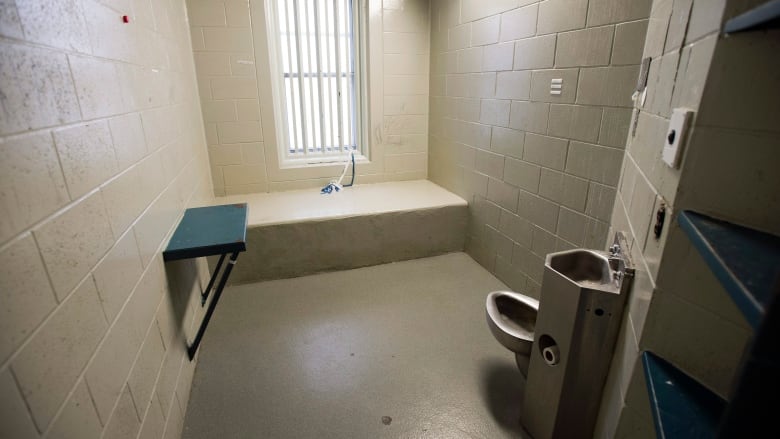Prison watchdog sees sharp decline in use of solitary confinement
Correctional investigator Ivan Zinger notes positive penitentiary trends in report

Canada's prison system is holding fewer inmates in solitary confinement, and for shorter periods of time.
Correctional investigator Ivan Zinger released new figures today showingthe number of admissions to segregation droppedin 2015-16, a trend that has continued into this year. The average length of stay in solitary is also down, from an average of 44 days in 2007-08 to 26 days in 2015-16.
"Correctional Service of Canada (CSC) for the last few years has dedicated a lot of time and effort to address the gross overuse of administrative segregation," he told CBC News in an interview.
Zinger said on any given day there are about 375 inmates held in segregation, less than half the average of 800 just a few years ago. He said the creation of special needs and mental health units has led to the drop.
In all, there were 6,792 admissions to segregation in 2015-16, dropping to the lowest figure in a decade. The total was down from 8,321 the previous year.
Admissions of federally sentenced women to segregation was down in the same period.
In 2015-16 there were 378 admissions involving 204 women, compared with 461 admissions involving 243 women the year before.
A breakdown of Indigenous offenders shows a marked decrease in admissions in 2015-16 after a decade of steady increases.The same pattern was reflected in the figures for black inmates; a decline last year after a decade that saw yearly increases.

While praising the correctional service for taking strong leadership and showing a commitment to creating alternatives to segregation, Zingerraised concernsthat some individuals who are moved into alternatives to segregation, which usually meanslockdown for 22 hours,may still be in highly restrictive routines with limited access to programs, services and employment.
"The numbers are down, but where those400-plus inmates went, it's unclear," he said.
Zinger said legislative reforms are required to ensure the positive momentum is maintained to further ease reliance on segregation, especially for inmates with mental health problems or those who are prone to self-harm.
Catherine Latimer, executive director of the John Howard Society of Canada, agreed thatlegislative reforms are needed, and said they shouldinclude a prohibition against segregation for those with mental illness, self-injurious behaviour or other conditions that would make theisolation "particularly cruel."
Cap consecutive days
She also raised concernsthat prolonged segregation, defined by the UN as longer than 15 days,is still occurring in Canada's prison system, and said the legislative framework should include caps on the number of consecutive days in isolation.
"Segregation is a denial of residual liberties which is a further punishment and must be done in a manner that respects fundamental principles of justice. This needs to be set out in the legislative reforms," Latimersaid.
Independent Senator Kim Pate, former executive director of theCanadian Association of Elizabeth Fry Societies, said CSC should work to abolish the use of segregation, particularly for women prisoners.
She agreed that the reduced use of segregation coincides with more restrictive overall conditions, some of which "amount to segregation by another name."
"This points to the need for judicial oversight and the importance of remedies for prisoners whose sentences are thus mismanaged by CSC," Pate said.
More men segregated
Of the current federal prison population of14,118, men were more likely to have a history of segregation than women (49 per cent compared with 36 per cent) and Indigenous offenders were more likely than non-Indigenous offenders to have been segregated (57 per cent compared with 46 per cent.)
Howard Sapers, the former correctional investigator,repeatedly called for tighter restrictions over solitary confinement after thehigh-profile inquest into the death of teen prisoner Ashley Smith.
Smith died in a segregated prison cell at the Grand Valley Institution for Women in Kitchener, Ont., in 2007. A coroner's jury ruled that her self-inflicted choking death was a homicide and made 104 recommendations to prevent similar deaths in future.
A homicide finding by a coroner's jury means the jury members found other people contributed to Smith's death, but the finding doesn't attach any criminal blame or liability.
Some critics and prisoners' advocateshave called for a total ban on segregation.
More women behind bars
Other statistics noted in Zinger's report:
- The population of women behind bars is up 38 per cent since 2007, while the male population increased by less than four per cent.
- The incarcerated Indigenous population increased 39 per cent since 2007, whilethe non-Indigenous population decreased by 3.4 per cent.
- The black population has increased by 42 per cent since 2007, whereas the Caucasian population decreased by nearly 15 per cent.













_(720p).jpg)


 OFFICIAL HD MUSIC VIDEO.jpg)
.jpg)



























































































